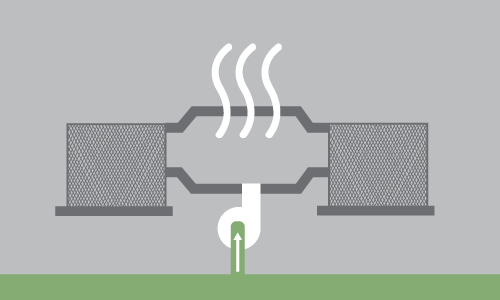There are many paths to pollution control. Depending on your industry, exhaust outputs, manufacturing size, and more, you have many options available when looking at pollution control systems. Notably, however, modern pollution control solutions utilize one of two methods to destroy pollutants: Thermal Oxidation and Catalytic Oxidation, both presenting their own pros and cons for different processes.
Today, we will look at the basics of oxidation and combustion, discussing how each process compares and offering you an opportunity to learn more.
Oxidation: Chemically Simple, Operationally Challenging
Something we all learned in our introductory chemistry classes, oxidation is a simple formula for converting organic compounds into carbon dioxide and water. As discussed in our blog on the three T’s of combustion (Time, Temperature, Turbulence), the combustion process occurs when the initial bonds of a carbon-based chemical are destroyed and bond with oxygen to form carbon dioxide and water. This is shown using the equation CxHy + O2 –> CO2 + H2O.
Sounds simple, and chemically stated, it is simple. Organic Compound + Oxygen = Carbon Dioxide + Water. However, as we went on to explain in the blog, this has to take place in a controlled environment that holds the chemical in the chamber for the right amount of time at the right temperature, mixed with the proper amount of oxygen in order to provide proper destruction efficiency, thermal efficiency, and cost efficiency as possible.
The last of these three, cost efficiency, is often a concern for companies, as many of the chemicals in exhaust streams require temperatures exceeding 1500°F for combustion to take place. Today, we would like to compare the thermal and catalytic oxidation process in the pollution control process, providing a brief primer on the differences.
Thermal Oxidation
Thermal oxidation is simple—apply as much activation energy (i.e. heat) as needed to convert a volatile organic compound and oxygen to carbon dioxide and water.
During this process, heat is applied to the exhaust stream (contaminated air), causing the bonds to break. After the bonds are broken, oxygen forms new bonds with carbon to form CO2 and hydrogen to form H2O (and additional heat).
While the process is simple—apply heat and add oxygen, the amount of activation energy needed to achieve the needed combustion temperature is high, resulting in higher operational costs.
There are ways to reduce operational costs—most notably through energy recovery or through the use of one of the following options: Thermal Recuperative Oxidizers or Regenerative Thermal Oxidizers.
Thermal Recuperative Oxidizer
Thermal Recuperative Oxidizers (TO’s) from The CMM Group destroy air pollutants emitted from process exhaust streams at temperatures ranging from 760°C (1,400 F) to 815°C (1,500 F). Using a multi-pass shell-and-tube heat exchanger to preheat the contaminated exhaust air, operating costs can be reduced.
Regenerative Thermal Oxidizer
Regenerative Thermal Oxidizers from The CMM Group are designed to destroy air pollutants emitted from process exhaust streams at temperatures ranging from 815°C (1,500 F) to 980°C (1,800 F). Through the use of airflow switching valves and ceramic media, clean process air is used to heat contaminated process air, also reducing the amount of energy needed to oxidize a chemical.
We’ve worked with companies all around the world to select and implement RTOs, including this plastics composites fabricator, this flexible printing operation, and this filter manufacturer.
Catalytic Oxidation
While the thermal oxidation process uses the direct application of heat, there are ways to reduce the amount of energy needed to start the combustion process—namely through the use of a catalyst.
By definition, a catalyst is any substance that increases the rate of a chemical reaction without itself undergoing any permanent chemical change. In biology, this could be an enzyme; in oxidation/combustion, this is done through the use of precious metals including platinum, palladium, rhodium, or other precious metals depending on the makeup of the exhaust stream.
Rather than directly applying heat to destroy pollutants, pollutants in catalytic oxidation are heated in a combustion chamber to temperatures ranging from 260°C (500°F) to 345°C (650°F) before it comes into contact with the catalyst, which in turn oxidizes the pollutant into carbon dioxide and water.
Ultimately, this results in lower operating costs and a smaller product footprint, while allowing organizations the ability to run a catalytic oxidizer in short cycles and offering comparable destruction efficiency ratings to thermal oxidizers. Learn more about the advantages of catalytic oxidation here.
Regenerative Catalytic Oxidizer
Just as the use of regenerative thermal oxidizers can reduce ongoing costs to heat air used to destroy pollutants, Regenerative Catalytic Oxidizers are able to operate in a similar manner without the extreme temperatures.
Catalytic Oxidizers from The CMM Group are designed to destroy air pollutants and volatile organic compounds in air from process exhaust streams at temperatures ranging from 260°C (500°F) to 345°C (650°F). After passing through the catalyst chamber, the clean (hot) air is routed back through the “hot” side of the heat exchanger where it continuously preheats the incoming process air.
Upon exiting the heat exchanger, the clean (cooled) air is routed to the atmosphere through an exhaust chamber and ultimately through the exhaust stack. Thermal recovery efficiencies (TRE) range from 50% to 80% and pollutant destruction efficiencies of 99% can typically be guaranteed.
Get to know a few companies who we’ve helped to select and install catalytic oxidizers, including this coating and laminating company, this pizza plant, and this baking operation.
Learn More: Air Pollution Control Solutions from The CMM Group
The CMM Group specializes in helping companies apply heat to get the job done. From oxidizers to ovens, we have the experience and expertise in process heating applications, energy recovery, and more. Our professional staff has many years of design, fabrication and sales experience in a wide range of industries from Aerospace Parts to Wood Finishing, and would love to help you with your next project. Get to know the basics of selecting and implementing air pollution control solutions by reading our VOC Abatement Guide and contact us for more information or to request a quote.




